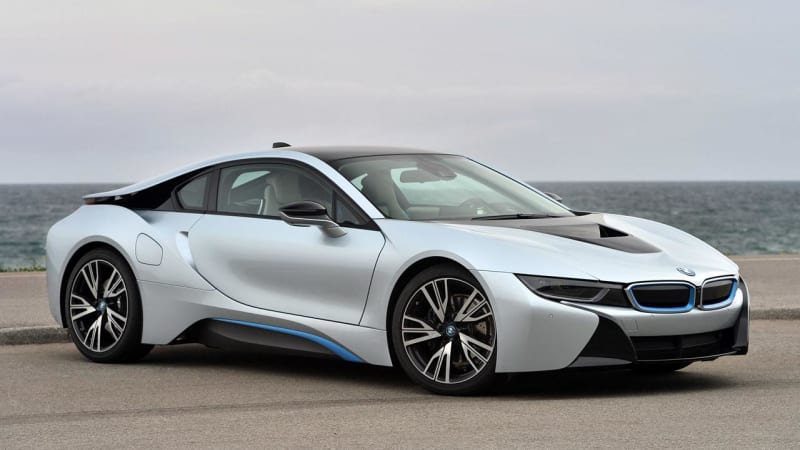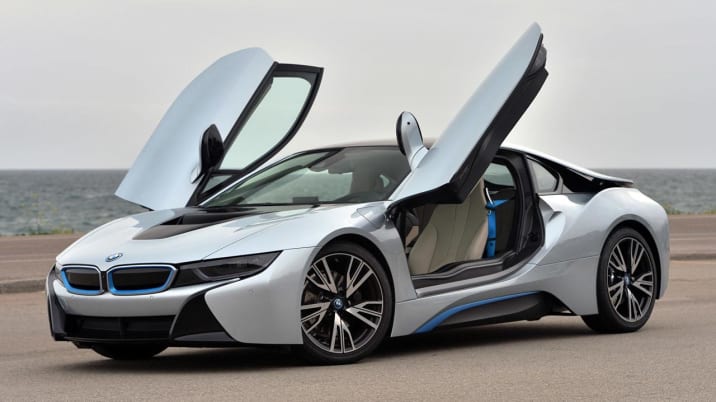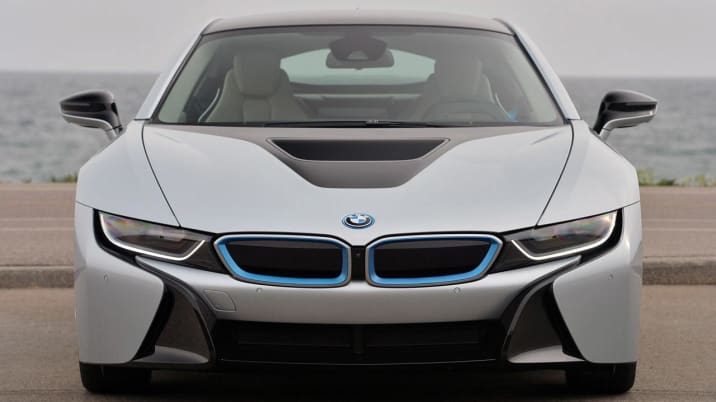
Why is there a BMW i8? Given the relative simplicity, affordability, practicality and energy efficiency of BMW's i3 sedan – available as a $42,000 all-electric or $46,000 extended-range EV – why design, engineer and build the much more complex and expensive ($137,450) but much less practical, exotic plug-in hybrid i8 2+2 sports car?
In 2015, BMW sold 2,265 i8s in the US, or about 189 a month. That compares to 11,024 (919 a month) for BMW's own i3, an estimated 27,840 (2,320 a month) for Tesla's battery-only EV Model S sedan and 1,024 (85 a month) for Cadillac's handsome, more practical and less expensive (but ridiculously overpriced and dismal-selling) ELR extended-range-EV luxury coupe. Are such sales really worth BMW's huge investment of engineering effort and dollars?
The i8's lightweight Carbon Fiber Reinforced Plastic (CFRP) "Life Module" passenger cell rides on an aluminum "Drive Module" chassis that houses its complex propulsion system – a 228-horsepower, 1.5-liter turbocharged gas 3-cylinder (half of BMW's 3.0-liter twin-turbo straight six) driving its rear wheels through a six-speed automatic and a 129-hp electric motor twisting its front wheels through a "two-stage" automatic – and a 5-kWh lithium-ion battery. Its drag coefficient (Cd) is an aero-slick 0.26, and BMW says it can run on battery energy alone for up to 22 miles.
Its total system output is a healthy 337 horses, and its EPA economy is 76 miles per gallon equivalent in gas-electric mode, but just 28 mpg when it's gas-only. A Driver Experience Control and an eDrive button offer EV and Comfort modes, plus Eco Pro (12 percent more range) and Eco Pro+ (12 more).
So what is this gorgeous plug-in hybrid sports car like to drive and live with? I missed its press launch so have been hoping for some quality time with one ever since. Production has been limited, and US press cars are few, but BMW said I would eventually get my chance. It finally happened.
If the unlovely i3 is a green technology revelation, this supermodel-sexy i8 is a green styling and performance revolution. If the i3 is the practical soccer mom of battery BMWs, the i8 might be the ultimate Teutonic trophy wife. But really, why do it?
For starters, just look at it. Some might see a new, high-tech take on the Giugiaro-designed BMW M1 mid-engine sports car. Just 453 of those were built from 1979 to 1981. But this low-riding rolling sculpture has so much more going on: swept-back nose with chrome-ringed kidneys flanked by squinty, LED-framed headlamps; sweeping rocker sculpting; flying-buttress raised rear roof; lightweight doors that open upward and outward like a bird's wings.

We drove it to dinner. Nearly everywhere it goes, nearly everyone double-takes and points. "What is that?" My car-loving wife was duly impressed by its looks but less by its challenging ingress and egress. Surprisingly, probably remembering its mostly freeway delivery drive the day before, its EV range gauge offered just 10 battery-only miles.
I found only one 12V outlet for my radar detector, under a cover in the very shallow bin atop the console. But plugging anything into it blocks the cover from closing, and the open cover protrudes into passenger space. The outlet proved powerless anyway (probably a blown fuse), so I would have to risk driving the i8 sans protection from (traffic ticket) revenuers.

On the up side, the wedgy i8 looked fabulous snuggled between parked SUVs at the restaurant, and it was fun watching people react to it. If we had chosen a fancier place with valet parking, it would have been posed proudly out front amid an array of big-ticket rides.
The dinner trip, plus two other stops, totaled 13.2 miles. We started EV Only, but the engine joined in after 8.3 miles of easy local driving. We arrived home with 387 miles of gas/electric range remaining and 41.4 mpg on the economy gauge.
Following an overnight plug-in, the i8's indicated EV range was up to 16 miles and total range to 403. I took it to a nearby Home Depot and back (not for siding or lumber), using 12 miles of EV range in 10.9 miles of Eco Pro+ EV-Only local driving. My trip fuel efficiency was an indicated 99.9 mpg (no gas burned) and my average economy was up to 45.7 mpg.
Even without a functioning revenuer detector, I had to give it an aggressive test, and it came through with typical BMW flying colors. There's no Sport mode, but its performance was exhilarating, its steering crisp, its handling planted and its braking sure and strong. It may be a fine-looking eco machine in normal driving, but it's an exotic AWD sports car on twisty roads.
Mostly because BMW can. Because such a production machine (unlike a one-off concept) is an indisputable rolling demonstration of its technology chops. Because its increasingly sophisticated state-of-the-art technologies will be rolled into future hybrids and electrics, most of them both more affordable and practical. Since both British marques are owned by BMW, these technologies will likely also migrate upward into Rolls Royce hybrids and MINI EVs.
For the same reasons Ferrari, McLaren, and Porsche have engineered and built hybrid supercars, and why Cadillac will likely try again. There are even rumors that the long-rumored mid-engine Chevy Corvette, which should appear fairly soon, may offer a hybrid or electric version. Because such high-dollar exotic green vehicles are all about reputation and image, leading to long-term sales success, rather than their own near-term sales and profitability.
The i8's lightweight Carbon Fiber Reinforced Plastic (CFRP) "Life Module" passenger cell rides on an aluminum "Drive Module" chassis that houses its complex propulsion system – a 228-horsepower, 1.5-liter turbocharged gas 3-cylinder (half of BMW's 3.0-liter twin-turbo straight six) driving its rear wheels through a six-speed automatic and a 129-hp electric motor twisting its front wheels through a "two-stage" automatic – and a 5-kWh lithium-ion battery. Its drag coefficient (Cd) is an aero-slick 0.26, and BMW says it can run on battery energy alone for up to 22 miles.
Its total system output is a healthy 337 horses, and its EPA economy is 76 miles per gallon equivalent in gas-electric mode, but just 28 mpg when it's gas-only. A Driver Experience Control and an eDrive button offer EV and Comfort modes, plus Eco Pro (12 percent more range) and Eco Pro+ (12 more).
So what is this gorgeous plug-in hybrid sports car like to drive and live with? I missed its press launch so have been hoping for some quality time with one ever since. Production has been limited, and US press cars are few, but BMW said I would eventually get my chance. It finally happened.
If the unlovely i3 is a green technology revelation, this supermodel-sexy i8 is a green styling and performance revolution. If the i3 is the practical soccer mom of battery BMWs, the i8 might be the ultimate Teutonic trophy wife. But really, why do it?
For starters, just look at it. Some might see a new, high-tech take on the Giugiaro-designed BMW M1 mid-engine sports car. Just 453 of those were built from 1979 to 1981. But this low-riding rolling sculpture has so much more going on: swept-back nose with chrome-ringed kidneys flanked by squinty, LED-framed headlamps; sweeping rocker sculpting; flying-buttress raised rear roof; lightweight doors that open upward and outward like a bird's wings.

Duck under those bird-wing doors, bend over, sit on the seat's edge, curl up your legs and swing them inside. Not easy, but ultimately rewarding. And well-placed door-pulls help. Lay your hands and eyes on the lovely steering wheel and surprisingly user-friendly controls and instruments. Most will be familiar to BMW drivers, though some are i8-specific, and all are bathed in cool blue light at night. Getting out can be even more challenging. Watch your head. And its vestigial rear seats are near-useless except to extend its barely-there storage capacity.Duck under the bird-wing doors, bend over, sit on the seat's edge, curl your legs, swing them inside. Not easy, but rewarding.
We drove it to dinner. Nearly everywhere it goes, nearly everyone double-takes and points. "What is that?" My car-loving wife was duly impressed by its looks but less by its challenging ingress and egress. Surprisingly, probably remembering its mostly freeway delivery drive the day before, its EV range gauge offered just 10 battery-only miles.
I found only one 12V outlet for my radar detector, under a cover in the very shallow bin atop the console. But plugging anything into it blocks the cover from closing, and the open cover protrudes into passenger space. The outlet proved powerless anyway (probably a blown fuse), so I would have to risk driving the i8 sans protection from (traffic ticket) revenuers.

On the up side, the wedgy i8 looked fabulous snuggled between parked SUVs at the restaurant, and it was fun watching people react to it. If we had chosen a fancier place with valet parking, it would have been posed proudly out front amid an array of big-ticket rides.
The dinner trip, plus two other stops, totaled 13.2 miles. We started EV Only, but the engine joined in after 8.3 miles of easy local driving. We arrived home with 387 miles of gas/electric range remaining and 41.4 mpg on the economy gauge.
Following an overnight plug-in, the i8's indicated EV range was up to 16 miles and total range to 403. I took it to a nearby Home Depot and back (not for siding or lumber), using 12 miles of EV range in 10.9 miles of Eco Pro+ EV-Only local driving. My trip fuel efficiency was an indicated 99.9 mpg (no gas burned) and my average economy was up to 45.7 mpg.
Even without a functioning revenuer detector, I had to give it an aggressive test, and it came through with typical BMW flying colors. There's no Sport mode, but its performance was exhilarating, its steering crisp, its handling planted and its braking sure and strong. It may be a fine-looking eco machine in normal driving, but it's an exotic AWD sports car on twisty roads.
I was truly sorry to see the i8 depart after a week of fuel-thrifty high living with it, and it delivered an impressive 47.3 MPGe average fuel economy in my week of local usage. Major kudos to BMW not just for doing it but for doing it so beautifully right. But why do it?But why do it? Mostly because BMW can.
Mostly because BMW can. Because such a production machine (unlike a one-off concept) is an indisputable rolling demonstration of its technology chops. Because its increasingly sophisticated state-of-the-art technologies will be rolled into future hybrids and electrics, most of them both more affordable and practical. Since both British marques are owned by BMW, these technologies will likely also migrate upward into Rolls Royce hybrids and MINI EVs.
For the same reasons Ferrari, McLaren, and Porsche have engineered and built hybrid supercars, and why Cadillac will likely try again. There are even rumors that the long-rumored mid-engine Chevy Corvette, which should appear fairly soon, may offer a hybrid or electric version. Because such high-dollar exotic green vehicles are all about reputation and image, leading to long-term sales success, rather than their own near-term sales and profitability.



No comments:
Post a Comment